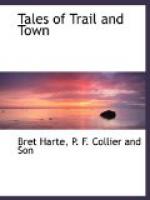“I am satisfied that much of the mischievous and extravagant prejudice against the half breed and all alliances of the white and red races springs from the ignorance of the frontiersman and his hasty generalization of facts. There is no doubt that an intermixture of blood brings out purely superficial contrasts the more strongly, and that against the civilizing habits and even costumes of the half breed, certain Indian defects appear the more strongly as in the case of the color line of the quadroon and octoroon, but it must not be forgotten that these are only the contrasts of specific improvement, and the inference that the borrowed defects of a half breed exceed the original defects of the full-blooded aborigine is utterly illogical.” He stopped suddenly and laid down his pen with a heightened color; the bugle had blown, the guard was turning out to receive the commandant and his returning party, among whom was Friddy.
*****
Through the illusions of depression and distance the “sink” of Butternut Creek seemed only an incrustation of blackish moss on the dull gray plain. It was not until one approached within half a mile of it that it resolved itself into a copse of butternut-trees sunken below the distant levels. Here once, in geological story, the waters of Butternut Creek, despairing of ever crossing the leagues of arid waste before them, had suddenly disappeared in the providential interposition of an area of looser soil, and so given up the effort and the ghost forever, their grave being marked by the butternut copse, chance-sown by bird or beast in the saturated ground. In Indian legend the “sink” commemorated the equally providential escape of a great tribe who, surrounded by enemies, appealed to the Great Spirit for protection, and was promptly conveyed by subterraneous passages to the banks of the Great River a hundred miles away. Its outer edges were already invaded by the dust of the plain, but within them ran cool recesses, a few openings, and the ashes of some long-forgotten camp-fires. To-day its sombre shadows were relieved by bright colored dresses, the jackets of the drivers of a large sutler’s wagon, whose white canvas head marked the entrance of the copse, and all the paraphernalia of a picnic. It was a party gotten up by the foreign guests to the ladies of the fort, prepared and arranged by the active Lady Elfrida, assisted by the only gentleman of the party, Peter Atherly, who, from his acquaintance with the locality, was allowed to accompany them. The other gentlemen, who with a large party of officers and soldiers were shooting in the vicinity, were sufficiently near for protection. They would rejoin the ladies later.
“It does not seem in the least as if we were miles away from any town or habitation,” said Lady Runnybroke, complacently seating herself on a stump, “and I shouldn’t be surprised to see a church tower through those trees. It’s very like the hazel copse at Longworth, you know. Not at all what I expected.”




